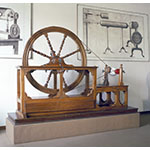Frictional electrical machine with white ceramic ovoid globe, secured between two wooden uprights in such a way that it can be easily replaced, for instance, when it gets broken because of excess friction. The leather cushion is attached to a flexible steel strip so that its pressure can be adjusted. Rapid rotation of the globe is made possible by the large spoked pulley wheel with two sheaves and a large handle on both sides, so that it can be turned by two men for lengthy experiments. The two sheaves of the pulley allowed two globes to be rotated at the same time. No fittings for a second globe have survived, but they may have disappeared in previous restoration.
In his Leçons de physique expérimentale (Paris, 1764 ed.)Jean-Antoine Nollet described a similar multi-globe machine, , which he employed for his physics demonstrations at the French court already in the 1740s. The separate prime conductor was suspended from the ceiling by silk ropes and collected the electric charge by means of a brass chain dangling onto the globe. The instrument was made in the workshops of the Museo di Fisica e Storia Naturale of Florence. A very similar version was described by Sigaud De La Fond still in 1771, in his Traité de l'électricité. Probably this is the only surviving example of a Nollet-type electrical machine. Provenance: Lorraine collections.










